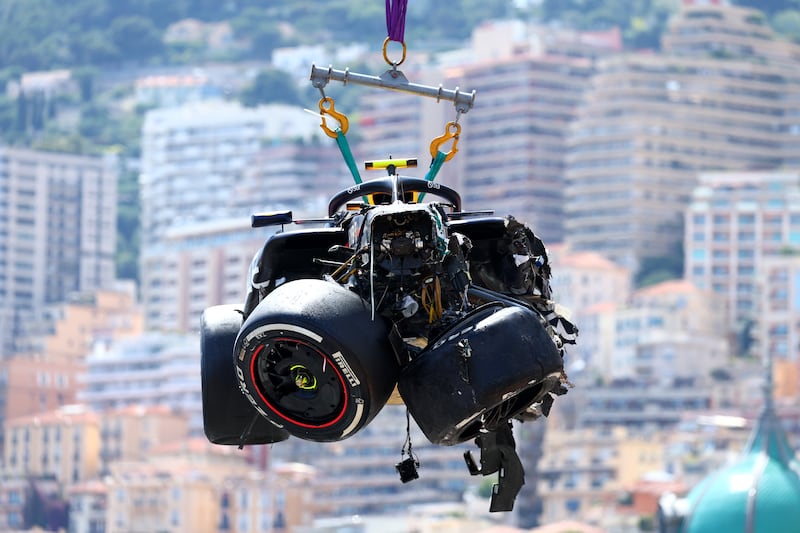Charles Leclerc won the Monaco Grand Prix, the Ferrari driver taking his first victory at his home race and becoming the first Monégasque to win here since the Formula One world championship began in 1950.
Leclerc beat McLaren’s Oscar Piastri into second and his Ferrari team-mate Carlos Sainz into third in a race marked by a horrifying crash on the opening lap for Red Bull’s Sergio Pérez.
Lando Norris was fourth for McLaren, George Russell and Lewis Hamilton in fifth and seventh for Mercedes, with the world champion, Max Verstappen, in sixth for Red Bull.
The race in Monte Carlo was a turgid procession once restarted after the crash, a drive which Leclerc controlled with admirable precision but no little monotony from the front. With the top 10 finishing in exactly their grid order, there was nary even an attempt at an overtake among them and, as Verstappen tooled round in a perfunctory fashion to claim sixth, the only real significance came in that his title lead over Leclerc was cut to 31 points.
The home crowd clearly were not bothered at how the win came as they celebrated and Leclerc was unsurprisingly absolutely joyous with his first win at his home race coming at the sixth attempt having never managed to make it to the podium previously. It has become known as the 26-year-old’s Monaco curse, a series of races where even his best chances seemed fated to fail.
He was scuppered from pole in 2021 after a crash at the close of qualifying forced his car’s retirement before the race began. Then in 2022, again on pole, Ferrari made a poor strategy call and his shot at the win fell away.
Having finally broken the hoodoo, Leclerc takes his first win since the Austrian GP in 2022 and Ferrari’s first victory at Monaco since 2017.
Leclerc held his lead on the short dash into turn one but the start was marked by a horrifying crash on the narrow streets as Pérez was lucky to walk away from a huge crash.
Pérez had started in 16th but going up Beau Rivage was clipped from behind by the Haas of Kevin Magnussen and as he slewed sideways, he was catapulted into the one wall then the other, leaving all but the reinforced cockpit of his car smashed to pieces strewn across the track with only one wheel left attached to what was left of his ride. Both the Haas cars were collected in the crash and all the drivers emerged unhurt but it led to a lengthy red flag period.
The scale of the crash was enormous and, taking place at approximately 150mph as they accelerate up the hill, it was a testament to the safety standards of the modern cars and the extensive testing, mandated by the FIA, before the season of what is known as the survival cell of the cockpit.

The FIA deemed it a racing incident and did not investigate further but racing did not resume for 45 minutes as the marshals had to repair the barriers, deformed by the force of the impact.
From a standing restart Leclerc held his lead once more and this time the field made it round the opening lap without incident. Having used the red-flag stoppage to change their tyres to the hard compound, the leading teams were set for a race without a required pit stop with 75 laps to go.
Leclerc led from Piastri and Sainz, the three leaders in close line astern within a second of one another by lap seven, with Norris just behind them and so it would remain.
This was very much a case of tyre and pace management prompted by the nature of the track and ensuring the rubber would make the distance and was very much the nose to tail procession that implies, as Leclerc controlled what was a very slow pace.
For all the laudation of the race as F1′s jewel in the crown, the crash had denied spectators what little jeopardy was left in pit-stop strategy, leaving but a relentless series of laps with no urgency at a torturously slow pace and with passing impossible, in a torpid train.
On lap 39 Ferrari told Leclerc to slow down even more, as unedifying a radio message as F1 has witnessed and a damning indictment of the anachronistic nature of the circuit, already criticised this weekend as being entirely unfit for purpose with modern F1 cars.
Hamilton and Verstappen both took a pit stop from their medium tyres in the final third, in an effort to make a difference, only for both to emerge in the same slots.
Verstappen hared off after Russell in fifth but even with fresher rubber could find no way past as Leclerc cruised to a victory he will have enjoyed from the cockpit but which was thin fare indeed for everyone else.
Yuki Tsunoda was eighth for RB, Alex Albon was ninth for Williams and Pierre Gasly in 10th for Alpine. – Guardian
- Sign up for push alerts and have the best news, analysis and comment delivered directly to your phone
- Join The Irish Times on WhatsApp and stay up to date
- Listen to our Inside Politics podcast for the best political chat and analysis














